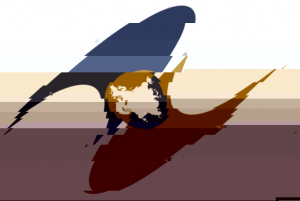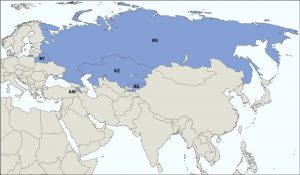 [1]
[1]
06/02/2017
By Justin Tomczyk
Of all the objectives of Vladimir Putin’s resurgent Russia, none are as critical as the restoration of the Russian sphere of influence. The dissolution of the Soviet Union and Warsaw Pact a quarter-century ago lead to the rapid erosion of Russia’s relevance on the world’s stage. Since then China, India, and other emerging powers have competed to define an increasingly multipolar world. While beset by demographic crises and economic turmoil, the Russian Federation continues to punch well above its weight and keep western policymakers on their toes. This policy brief will analyze one of the largest Russian-lead regional bodies in the former Soviet Union – the Eurasian Economic Union (EAEU) – and its role in the reestablishment of Russia as a world power.
Above are the flags of the Eurasian Economic Union. On the left, proposed flag of the EAEU. On the right is the final design of the EAEU flag (Wikipedia Commons).
The Eurasian Economic Union(EAEU) is a regional organization similar to the European Union(EU) in function and purpose. Members of the EAEU are considered part of a single market and customs union, known as the “Single Economic Space”. Citizens of EAEU member states are allowed to work, reside, and travel between other EAEU members while laws regarding ownership of property and capital are harmonized throughout the EAEU. The EAEU is currently composed of Armenia, Belarus, Kazakhstan, Kyrgyzstan and the Russian Federation – altogether totaling 183 million people with a combined economy roughly the size of Italy.
Above is a map of the Eurasian Economic Union. Not including de-facto members South Ossetia, Abkhazia, Nagorno-Karabakh, Luhansk People’s Republic, and Donetsk People’s Republic (Wikipedia Commons).
While the idea of a “Eurasian Union” was first proposed by President Nursultan Nazarbayev of Kazakhstan, the EAEU is largely built on the bones of the Commonwealth of Independent States (CIS) – an organization formed after the collapse of the Soviet Union designed to offer a sort of “civilized divorce” between former Soviet Republics. Many EAEU benefits (free trade between members, enhanced residency rights, inclusion in cooperative projects) either existed in some form within the CIS or through individual bilateral agreements with Russia. Of the original 12 CIS members only five sought full membership in the EAEU. Of the four non-Russian EAEU members, two are heavily dependent on remittances from citizens in the Russian Federation1 (Kyrgyzstan and Armenia) while two have arguably been Russia’s closest allies since the collapse of the USSR (Belarus and Kazakhstan). When looking at the division of power within EAEU supranational bodies (such as the Eurasian Economic Commission) Russia’s immense economic weight and population make it impossible for EAEU members to enact policy without Moscow’s consent. While the European Union’s political system is designed to equalize influence as much as possible and minimize unilateral decision-making, the scales of the EAEU are tipped decisively in Russia’s favor.
Since the Russian Federation represents the majority of the EAEU’s economy and most of the union’s benefits are derived from earlier treaties, the organization provides no direct economic benefit for Moscow. Instead, we need to consider the political gains that an entity like the EAEU would provide and how the Eurasian Economic Union relates to larger scope of Russian foreign policy in the former Soviet Union.
Despite the Russian military physically occupying areas of Georgia, Moldova, and Ukraine, these countries have been able to pursue a healthy degree of economic and political association with the European Union. China’s “One Belt, One Road” (OBOR) project has caught the eyes of unitary states like Uzbekistan who find China’s “strictly business” Central Asia policy more appealing than subservience towards Russia.[2] As a tool of Russian soft-power, the strategic value of the EAEU is its function as a demarcation line against other competing geopolitical projects in the former Soviet Union.
Expansion of the EAEU offers Russia the opportunity to fight both Chinese and European geopolitical influence in a way that is more comprehensive and binding than simple bilateral trade agreements. Upon signing their EAEU membership agreements, Armenia and Belarus effectively paused their participation in the European Union’s Eastern Partnership project.[3] By joining the EAEU these states committed themselves adopting EAEU standards of industry and trade, the bulk of which are incompatible with the bureaucratic standards of the European Union’s single market. This limits engagement between the EU and Armenia/Belarus to political dialogue and basic investment deals rather than association agreements and eventual membership. While Kazakhstan and Kyrgyzstan have pursued a limited degree of engagement with OBOR, the necessity of residency rights for Kazakh and Kyrgyz citizens in Russia has kept both countries firmly within Moscow’s reach.[4] While still a fraction of the entirety of the U.S.S.R and Warsaw Pact, Russia has solidified its influence in roughly a third of the former Soviet Union.
In terms of expansion and integration the Eurasian Economic Union has seen mixed success. The contraction and slow-growth of the Russian economy over the past three years has lead to a spillover effect in other EAEU members. The absence of Ukraine – one of the largest markets for Russian goods and energy – from the EAEU has left a noticeable dent in the EAEU’s population and economy. Like a true collection of autocrats, heads of EAEU member-states find themselves prioritizing their limited engagement with external bodies over political cooperation and deepening the union’s scope and function.[5] While the union has seen success in the establishment of a free trade agreement with Vietnam and the hopes to eventually include Tajikistan as a full member, efforts to corral regional powers like Iran into an effective partnership or expand the union’s influence beyond historic Cold War partnerships have fallen flat.
Because Russia represents the bulk of the EAEU’s population, economy, and geographic area, it’s important that policy makers view the organization as an extension of the Kremlin rather than a truly independent body. While there have been instances of EAEU members (like Belarus) being used as a means to bypass sanctions placed on the Russian Federation,[6] the deepening of economic integration within the EAEU will lead to the spread of Russia’s economic woes to other members of the organization.
From a policy perspective, regional powers should prioritize engagement with non-EAEU members in the former Soviet Union over trying to pull EAEU members out of the organization. For instance, the European Union should continue its association with Georgia while pushing for an expanded partnership with Azerbaijan instead of trying to pry Armenia from the EAEU. This is because EU agreements and treaties with Armenia are limited to the parameters allowed by the EAEU, while a non-aligned country like Azerbaijan has a wider latitude for cooperation.
It’s key that the European Union treats the Eurasian Economic Union as a single market – meaning that sanctions placed on one member are extended to all members. This will force EAEU members to consider the costs of their association with Russia and evaluate the political and economic implications of such a relationship. This also gives legitimacy to the idea of a unified economic space – as seen in the EU, EAEU, and other regional unions around the world.
References:
[1]“Remittances in Armenia: Dynamic Patterns and Drivers”
https://www.imf.org/external/country/arm/rr/2012/062012.pdf
[2]“The Multiple Dimensions of China’s ‘One Belt One Road’ in Uzbekistan”
http://schillerinstitute.org/economy/phys_econ/2016/1227-obor-uzbek/ou.html
[3]“When choosing means losing: The Eastern partners, the EU and the Eurasian Economic Union”” http://www.europarl.europa.eu/RegData/etudes/STUD/2015/549026/EXPO_STUD(2015)549026_EN.pdf
[4]“Eurasian Economic Union: Current state and preliminary results”
http://www.sciencedirect.com/science/article/pii/S2405473917300041
[5]“Belarus Cancels Visas for Citizens of 80 States”
belarusfeed.com/breaking-belarus-cancels-visas-for-80-states
[6]“Belarus and Russian Food Embargo: A Success Story?”
http://belarusdigest.com/story/belarus-and-russian-food-embargo-success-story-23073

